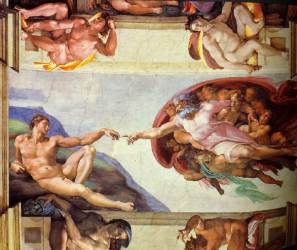
A peculiar system
of morality, veiled in allegory and illustrated by symbols.
This is the answer to the question, ‘What is Freemasonry?’ I maintain that, by giving such a shorthand answer, we may be
short-changing ourselves. This is,
and is intended to be, a quick answer which endeavours to describe that which,
in fact, cannot be described in words of one syllable, indeed may not be
described adequately in words at all. The
central word of that phrase is ‘allegory’, and therein lies the clue: we may
not name, in words, that which is only describable by allusion, inference,
hints, signposts, codes.
The name may not necessarily
impart the essence.
If you point to a
picture of a tiger and say to a child ‘tiger’, for that child, who has never
seen a real tiger, the picture itself assumes the name ‘tiger’, and the real
animal will then need another name entirely to identify it.
The picture does not communicate the essence of the animal.
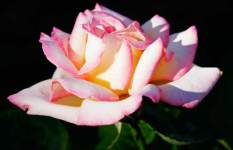 To take another
example: asking someone to describe the delicate colour of a flower has similar
dangers: to me it may be pink; to another it may be golden yellow; but in fact
that colour may be unique to that flower, and may have no name at all.
Umberto Ecco maintained that the name of the rose was not its essence:
that to name it, was to become immersed in the name, which diverts us from
experiencing its peculiar beauty, its colour, its scent, the texture of its
petals. ‘Oh yes, I have a lot of
roses in my garden,’ you may tell me. But
that doesn’t tell me anything about them.
I have to go to your garden and experience for myself what you have done
your best to describe, but which still leaves me wanting to know more.
Ecco went so far as to say that naming something destroys it.
To take another
example: asking someone to describe the delicate colour of a flower has similar
dangers: to me it may be pink; to another it may be golden yellow; but in fact
that colour may be unique to that flower, and may have no name at all.
Umberto Ecco maintained that the name of the rose was not its essence:
that to name it, was to become immersed in the name, which diverts us from
experiencing its peculiar beauty, its colour, its scent, the texture of its
petals. ‘Oh yes, I have a lot of
roses in my garden,’ you may tell me. But
that doesn’t tell me anything about them.
I have to go to your garden and experience for myself what you have done
your best to describe, but which still leaves me wanting to know more.
Ecco went so far as to say that naming something destroys it.
No. The essence of
Freemasonry may not be put into words. We
are not dealing in facts. We can
however get a little further by asking, not ‘What is Freemasonry?’ but
‘What does Freemasonry do?’. In
its little square booklet Freemasonry: An
Approach to Life, the United Grand Lodge of England asks the question
‘What is Freemasonry?’ but then, curiously, it does not tell us what it is,
but rather what it does.
‘Freemasonry,’
it says, ‘teaches moral lessons and self-knowledge, through participation in a
progression of allegorical two-part plays’.
Now, I would like you to think what would happen if we put these
statements the other way round:
FREEMASONRY
TEACHES SELF-KNOWLEDGE AND MORAL LESSONS, THROUGH PARTICIPATION IN A PROGRESSION
OF ALLEGORICAL TWO-PART PLAYS
in other words, by
first coming to understand, and to know, ourselves, in order afterwards to
attain moral lessons. Are we here
on more secure ground? Well, I
think we are.
In order to understand ourselves, and through that to claim a knowledge
of ourselves, we have to concentrate on what makes us what we are.
In fact, a definition of what Freemasonry does might well be:
‘Freemasonry
provides a path to be followed in progressing towards our own centre, to
discover the mystery which is our Self, the beauty in our Self, and the mystery
of the spark of divinity within us’.
Now we are talking about mysteries, those glories which can be imparted
by decoding the allegories. What is
more, in dealing with the mystery of Freemasonry, we are engaged in the pursuit
of the oldest western mystery tradition of all.
Our ritual abounds in references to the Centre.
Let us start at the beginning. Explicit
reference to the Centre is not the sole province of the third degree, but is in
fact first mentioned in the first degree. It
is a pity that the first degree tracing board, which has a specific reference to
the Centre, is not often explained to the new Entered Apprentice right at the
start of his or her masonic journey. Let me remind you what it says:
‘In all regular,
well-formed, constituted lodges, there is a point within a circle round which
the Brethren cannot err; this circle is bounded between north and south by two
grand parallel lines, one representing Moses, and the other King Solomon. On the upper part of this circle rests the Volume of the
Sacred Law, supporting Jacob’s ladder, the top of which reaches to the
heavens’ . . . and it goes on . . . ‘In going round this circle, we must
necessarily touch on both those parallel lines, likewise on the Sacred Volume,
and while a mason keeps himself thus circumscribed, he cannot err’.
This is a fairly direct injunction.
What injunction? Well, in
the midst of allegory, I must not be dogmatic.
So I will say ‘It seems to tell us that’ this symbol points to the
need to be self-aware, self-knowing, to know our own centre.
Here we should be careful to distinguish between self-centredness, a
scenario in which we are bound up in being interested in ourself to the
exclusion of those around us, and self-awareness, a scenario in which we first
seek to be aware of, and to know, our own nature, virtues and vices, after which
we can then be secure enough in ourselves to relate to those around us.
A self-centred person may indeed be seeking self-knowledge, but may not
have progressed beyond an empty feeling of self-inadequacy.
So: we enter the temple at
our initiation blindfolded. I think
we all know why this is, but let me crave your indulgence to expand on it a
little. We begin our life in the darkness of the womb. We
end it in the darkness of the tomb. Between
those two extremities, light is essential to our progress, in a literal,
physical sense as well as in a figurative, symbolic sense. Of
all the organs of sense with which humans have been blessed, the eyes are the
most perceptive. Deprived of light,
we are more helpless than when deprived of any other sense.
But deprived of spiritual light we can be yet more disabled. We may
indeed have come to Freemasonry seeking spiritual progress because our own inner
light, our own centre, was shining not as brightly as it might. When we set out on our masonic journey, we were told that we
would be deprived of light, so that did not come as a surprise to us. But
the reason for this deprivation only became clear once we were on our way. We were not to take notice of light from outside, nor indeed
outside influences of any kind, so that we might better concentrate on what was
happening inside, so that we might identify and appreciate the inner light. This
was a light which was faint at first, growing stronger as we felt our spirit
grow stronger.
But first of all, there was a crucial event in our initiation.
The Master recited a prayer over the aspirant:
Vouchsafe Thine
aid, Almighty Father and Supreme Governor of the universe to our present
convention, and grant that this candidate for Freemasonry may so dedicate and
devote his life to Thy service as to become a true and faithful Brother among
us. Endue him with a
competency of Thy divine wisdom that, assisted by the secrets of our masonic
art, he may the better be enabled to unfold the beauties of true godliness, to
the honour and glory of Thy holy name.
By reciting the words of this prayer, the Master recognises that the
aspirant is in need of initiation as a route away from his base self, rising to
a fuller, brighter existence, a real moral and ethical advancement in himself, a
journey towards God. He gives
recognition to the fact that the aspirant is in need of wisdom, and which of us
is not?
But, and this is important, the words of this prayer conceal something of
supreme importance for Freemasons. ‘ . . . that he may the better be enabled
to unfold the beauties of true godliness . . .’
We have first to ask ourselves: how am I to unfold the promised
godliness? Then we have to ask: and
where is it situated?
One explanation of this is as follows. I must ask you to fasten your
seatbelts and hold on for a moment, because this is not the sort of talk we are
used to in lodges of instruction. I
want you to accept for a moment that we actually inhabit two universes at the
same time. There is the physical,
material, sensual world – a world
with hard edges so to speak – and there are the limitless, eternal realms, not
restricted by physical phenomena, and not available to ordinary perception, but
which are still a part of our universe. Quests
for an explanation of non-material phenomena have existed since the beginning of
the human race. In the ancient
world, these quests belonged to a body of thought known as the Mysteries. In
these realms, the arenas for the exploits of the gods of mythology, events
occurred which were governed by the same natural laws existing in our world of
ordinary experience, and had an important influence on the daily activity of
human life. To illustrate this, every time we dream, we are participants
in supernatural events, since the boundary of the inaccessible part of that
supernatural domain is the threshold of our own consciousness. The Mysteries were schools which provided the gateway to those
realms, and the natural laws operating in them, and incorporated in the practice
of the ancient Mysteries was a process of initiation directly comparable with
masonic initiation.
In those ancient times, from those realms where the writers of our ritual
very probably took their inspiration, the Greek god Hermes formulated the idea
‘As above, so below’ as an induction into explaining the universe. The
full saying is ‘That which is above is like that which is below, and that
which is below is like that which is above, to achieve the wonders of the
One’. This encapsulates the idea that the universe is the same as God; God is
the same as man; man is the same as the cell; the cell is the same as the atom,
and so on. To sum it up, this message theorises that man is the
counterpart of God on earth, just as God is man’s counterpart in life eternal.
Therefore it is a statement of an
ancient belief that man’s actions on earth mirror the actions of God in life
eternal.
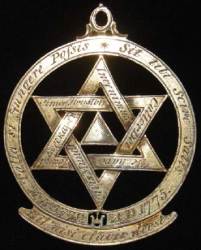
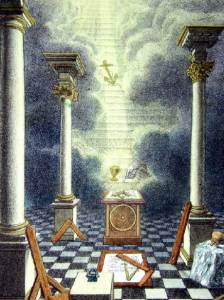 We have a way of representing this in Freemasonry by two important
symbols. The hexalpha is a six-pointed star formed by inverting one triangle
over another and interlacing them, in such a way that one point is directed
towards heaven, and the other towards earth, pointing out how man’s nature,
the ‘below’, is inextricably that of God, the ‘above’. Jacob’s
ladder (see the image on the right) similarly illustrates that earth and heaven are connected, with angels
both ascending and descending on it.
We have a way of representing this in Freemasonry by two important
symbols. The hexalpha is a six-pointed star formed by inverting one triangle
over another and interlacing them, in such a way that one point is directed
towards heaven, and the other towards earth, pointing out how man’s nature,
the ‘below’, is inextricably that of God, the ‘above’. Jacob’s
ladder (see the image on the right) similarly illustrates that earth and heaven are connected, with angels
both ascending and descending on it.
This is a long way of saying that, if man’s consciousness is brought to
bear on his own nature, he may discover that element within himself which is
divine. We often call our own or
others’ gifts ‘God-given’, meaning that without divine aid, our own
efforts are worthless. One of the
psalms in the old testament says ‘Except the Lord build the house, they labour
in vain that build it: except the Lord keep the city, the watchman waketh but in
vain’. By our own heightened
state of consciousness in the lodge, we may arrive at that state where our own
nature approaches that of God, but if our endeavours are those of the rational
mind alone, without divine intervention, they will be incomplete. We may be able to build better through self knowledge, that
is, knowledge of a potential in ourselves that we may never have realised, a
potential that reflects the divine spark which resides in each one of us.
In the lodge of Entered Apprentices in which we were initiated, light was
witheld only from us, not from the other members of the lodge, because the
journey was ours alone, the journey away from the darkness of un-knowing to the
light of knowledge of our Self. The
other members of the lodge were there to help us on the journey, but they could
not take part, since the journey was the journey towards knowledge of our Self,
the journey towards our own centre.
We may often think that we know ourselves, but this may be an illusion. If
we regard ourselves in a mirror, do we believe that we see the true image, the
true person as he or she is? Of
course we do not. We see something
very close to the real person, but we do not see ourselves as others see us,
because the mirror has transposed our features – the left side has become the
right, and vice versa. So it is
clear that we will have to go deeper than skin deep to investigate the real
self, with its virtues and vices, strengths and failings, smooth ashlar and
rough ashlar.
Our restoration to material light later, followed the question ‘Having
been kept for a considerable time in a state of darkness, what is the
predominant wish of your heart, your centre?’. The
considerable time referred to here is not merely the time that has elapsed since
we were admitted to the Temple – it refers to the time, perhaps since birth,
that we have spent wishing for more light for our heart and for our spirit. It
refers to the considerable time most of us spend in darkness, removed from
spiritual riches, and therefore in true poverty.
Let us proceed further along this allegorical highway. Part of the journey to the centre in the second degree is
only mentioned in the third, and it is this.
PROCEEDING
ONWARDS, STILL GUIDING YOUR PROGRESS BY THE PRINCIPLES OF MORAL
TRUTH, YOU WERE LED, IN THE SECOND DEGREE, TO CONTEMPLATE THE INTELLECTUAL
FACULTY, AND TO TRACE IT, FROM ITS DEVELOPMENT, THROUGH THE PATHS OF
HEAVENLY SCIENCE, EVEN TO THE THRONE OF GOD HIMSELF. THE SECRETS OF NATURE, AND THE PRINCIPLES OF
INTELLECTUAL TRUTH, WERE THEN UNVEILED TO YOUR VIEW.
Now, like all good
allegories, this needs decoding. I
would ask you to consider that the secrets of nature are the intricacies of our own nature, and the intellectual truth is our knowledge of that intricate nature, a knowledge based not on
book-learning but on the intuition of the heart. This would make perfect sense of our approach, in the second
degree, to the middle chamber, that place where we come to know the name of God,
where we can sense that we have come nearer to knowing the nature of God, and to
identify, following the first degree prayer, that part of our Self which we call
the divine spark, the goodness of our own spirit.
Yet in the second degree we are in touch only incompletely with our own
divinity. We have progressed, in
the first degree, towards heart perfection.
‘Where were you first prepared to be made a mason?’
‘In my heart’. In the
second, by the help of the seven liberal arts and sciences, we have come to know
our intellectual nature, that place where we can now come to know the
name of God. Now – discovery
is not limited to the secrets we find in the third degree.
As we close the lodge in the second degree we say
IN THIS POSITION,
WHAT HAVE YOU DISCOVERED?
A SACRED SYMBOL.
WHERE IS IT
SITUATED?
IN THE CENTRE OF
THE BUILDING.
TO WHOM DOES IT
ALLUDE?
THE GRAND
GEOMETRICIAN OF THE UNIVERSE.
The centre of the
building can therefore be the physical temple in which we have been working; it
can be the temple of humanity, in whose construction we are, hopefully, taking
part; it can also be – it must also
be – the centre of our own building,
that space which we seek to investigate on our masonic journey, and in which we
hope to discover ever more elements of divinity within ourselves.
So – we progressed to the heart-centre in the first degree; we
progressed to the mind-centre in the second.
It only remains to discover the spirit-centre.
And to do this, we need, in the third degree, to cross some thresholds.
The first of these thresholds, namely admission to the third degree
lodge, is passed
BY THE HELP OF GOD
AND THE UNITED AID OF THE SQUARE AND COMPASSES.
As we know, the
square no longer predominates over the compasses. Both points are revealed –
our material concerns no longer take precedence over our spiritual progress, and
thus all three of the great lights will be accessible to us.
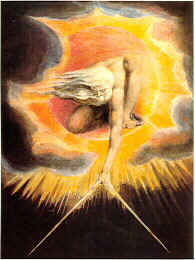 But there are still more thresholds to come in this sublime degree. We
pass the threshold of the grave, leaving our own mortal nature with all its
transgressions behind. We pass the
threshold of the communication of the five points of fellowship, a sublime
lesson of how to lead our lives in relation to humankind and to our Brethren in
particular. But of supreme
importance, we pass from the middle chamber of the temple into the sanctum
sanctorum, where the light of the blazing star floods in through the dormer,
where we stand face to face with the Most High, and acknowledge our one-ness
with Divinity, and discover, finally, that which we unfolded by the prayer in
the first degree, namely your own
centre, the spark of divinity within ourselves.
But there are still more thresholds to come in this sublime degree. We
pass the threshold of the grave, leaving our own mortal nature with all its
transgressions behind. We pass the
threshold of the communication of the five points of fellowship, a sublime
lesson of how to lead our lives in relation to humankind and to our Brethren in
particular. But of supreme
importance, we pass from the middle chamber of the temple into the sanctum
sanctorum, where the light of the blazing star floods in through the dormer,
where we stand face to face with the Most High, and acknowledge our one-ness
with Divinity, and discover, finally, that which we unfolded by the prayer in
the first degree, namely your own
centre, the spark of divinity within ourselves.
In the sanctum sanctorum, where our base self is not buried, we come face to face with God. Aided
by divine light and wisdom we have pierced the veil. We
have lifted our eyes to God’s hope for us, the bright morning star. We have trodden evil underfoot. We are now listening to the voice of our own purified nature
and are coming to know our own vital and immortal principle, namely that light
and goodness of which we are all capable.
And the third of the three Great Lights, the compasses, are given to us
to work with. The compasses, we are
told, define the limits of good and evil. By
adhering to the centre, where the first leg of the compasses is placed, we
adhere to the moral law. To stray
over the limit set by the other leg of the compasses is to disregard the moral
law, that code by which we live in harmony with our fellow-men. In
the words of the first degree, while we keep ourselves thus circumscribed, we
cannot err.
We have all had the three degrees conferred on us.
We may not have had all this in mind as we progressed, but we certainly
can open our hearts to such insights now, in whatever form suits us best – it
doesn’t have to be my way! And
perhaps we can now, with such insight, impart something of this to those whom
we, in our turn, initiate pass and raise, so that they in their turn, may find
their own way to the centre.
|
![]() News Feed |
News Feed |  Subscribe News by Email
Subscribe News by Email